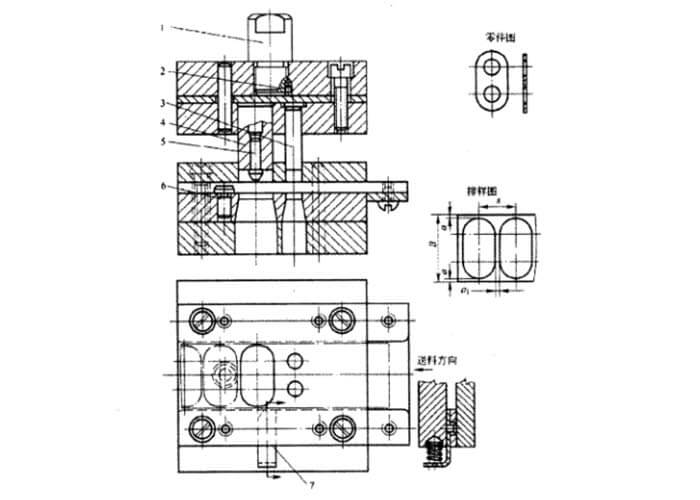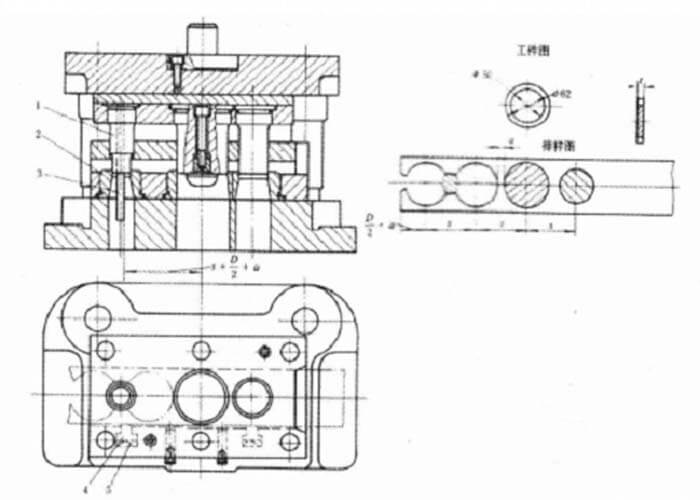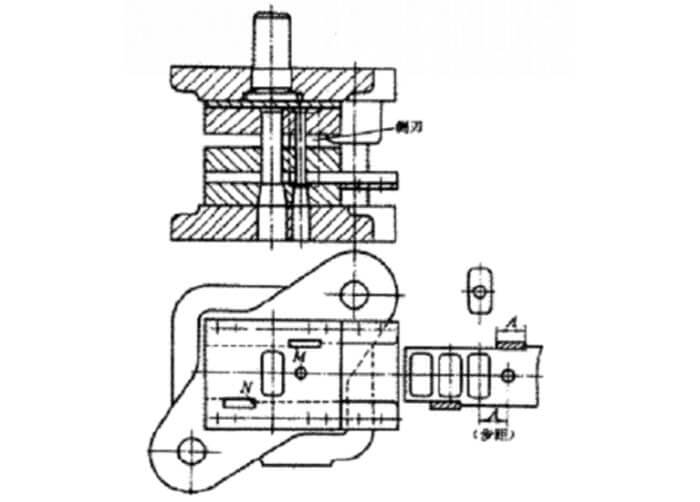What is progressive stamping die?
Progressive stamping is a metalworking method that can encompass punching, coining, bending, and several other ways of modifying metal raw material, combined with an automatic feeding system. The feeding system pushes a strip of metal through all of the stations of a progressive stamping die.
The progressive stamping die refers to a cold stamping die that uses a strip of stamping raw material to complete multiple stamping processes simultaneously with several different stations on one die in one stamping stroke, and the material strip moves at a fixed distance once for each stamping stroke until the product is finished.
Classification of a progressive stamping die
Progressive stamping die (also known as a progressive stamping die, progressive die stamping, continuous casting) is a die in which the press completes several processes at the same time in several different positions in one stroke.
The stamping parts are formed gradually in the progressive stamping die. Continuous forming is a process concentration method, which can make multiple processes such as edge cutting, notching, grooving, punching, plastic deformation, and drop material to be completed on one die.
According to the actual needs of the stamped parts, multiple stamping processes (called stations in progressive die) are arranged in a certain order for continuous stamping.
It can complete not only the punching process but also the forming process and even the assembly process. Many complex stamping parts that require multi-process stamping can be fully formed on one die, which provides favorable conditions for high-speed automatic stamping. Thus, a progressive stamping die is a kind of punching die with many workstations and high efficiency.
Due to the high number of stations in a progressive stamping die, it is necessary to solve the problem of accurate positioning of the strips or strips to ensure the quality of the stamped parts. According to the characteristics of the parts positioned in the progressive stamping die, it has the following typical structures.
Progressive stamping die with guide pins for positioning
Figure 1 below shows a progressive stamping die for punching and dropping with a guide pin. The distance between the punching die 3 and the drop die 4 is the feed step. During operation, the initial position of the strip is defined by the starting stopper pin and the two holes in the first part are punched.
After the initial stopper pin is reset by the spring, the strip is fed in one more step, and the fixed stopper pin is used for coarse positioning, and the two guide pins mounted on the drop die are used for fine positioning during the drop. The accuracy of the relative position of the hole and the shape on the part is guaranteed.
At the same time, two more holes are punched in the punching station, so that the punching process is carried out continuously until the strip is finished. The die is fitted with a guide pin of H7/r6 and the connection should be easy to install and dismantle when the die is resharpened, therefore, the hole for the guide pin in the die is a through-hole. The shape of the head of the guide pin should be suitable for insertion into the punched hole when guiding, and it should have a slight clearance with the hole.

This spacing method is mostly used for thicker plate materials, punched parts with holes, and punched parts with accuracy lower than the ITl2 level. It is not suitable for soft material or punching parts with plate thickness less than 0.3mm, or punching parts with hole diameter less than 1.5mm, or small drop die.
With this type of progressive stamping die, when the shape of the stamped part is not suitable for positioning with the guide pin (such as the hole diameter is too small or the hole distance is too small, etc.), the process hole can be punched in the waste part of the strip and guided by the guide pin mounted on the fixed plate of the cam die.
The progressive stamping die generally has a guide device, and this die is guided by a guide plate with a clearance fit to the convex die, and the guide plate is used to unload the material.
To facilitate operation and further increase productivity, automatic stop positioning or automatic feeding device with positioning parts can be used for positioning.
Figure 2 below shows a progressive stamping die with automatic material stopping. The automatic stopper device consists of a stopper bar, a convex die for punching the lap edge, and a concave die.
The two feeds of the punch and the drop are positioned by the two starting stopper pins, while the third and subsequent feeds are positioned by the automatic stopper.
Since the stopper rod never leaves the upper plane of the concave die, when feeding, the stopper rod blocks the lap edge, and at the same time of punching and dropping, the convex and concave dies punch out a gap in the lap edge, so that the strip can continue to feed a step, thus playing the role of automatic material stopper.
In actual production, there are other forms of automatic blocking devices.
In addition, the mold is equipped with a side pressure device, through the action of side pressure reed and side pressure plate, to press the strip to the opposite side, so that the strip feeding direction is more accurate.

Progressive stamping die with side edge spacing
The working principle of side edge pitching. The working principle of side edge pitching is shown in Figure 3 below. In addition to the general punching and drop die, the die fixing plate is equipped with a special die – the side edge.
The length of the side edge section is equal to the feed step. In each stroke of the press, the side edge punches a piece of material at the edge of the strip with a length equal to the step.
Since the width between the front and rear guides of the side edge is different, wide in the front and narrow in the rear, a convex shoulder is formed at M of the guide, so that only after the side edge cuts off an edge of length equal to the step and reduces its width, the strip can be fed one more step forward, thus ensuring the correct position of the hole in relation to the profile.

Features of progressive stamping die
(1) One set of progressive stamping die can complete multiple processes such as punching, bending, forming, and deep drawing. The press can produce one workpiece or process piece per stroke, so it has higher labor productivity than the compound die.
(2) The use of progressive stamping die can reduce the number of equipment, dies, and workshop areas, and eliminate the transfer and storage of semi-finished products.
(3) Progressive stamping die uses coil or strip material and feeding, discharging, and stacking are easily automated. During the stamping process of automatic progressive stamping die, human body parts do not need to enter the dangerous area, and the operation is safe.
(4) The processes of the progressive stamping die are scattered in each station, and there is no problem with the minimum wall thickness of the compound dies, so the die has higher strength and longer life.
(5) The structure of continuous mold is complicated, high precision, long cycle time, high cost, and difficult to maintain.
(6) Since each process is done in different stations, the cumulative error of positioning will affect the accuracy of the workpiece, so the accuracy of the workpiece produced by the progressive stamping die is not high.
Application of progressive stamping die
The following aspects should be considered for the application of a multi-station progressive stamping die for a stamped part.
Design, production, and maintenance of progressive stamping dies
The structure of a multi-station progressive stamping die is quite complex and the manufacturing accuracy is much higher than that of a normal die. After each mass production, it must be overhauled and sharpened, and it can be put into storage only after passing the test punch. Some small convex die, inserts must be replaced in time after wear or damage.
For multi-station progressive stamping die of bending, deep drawing, and forming, when sharpening the edge of the convex die and concave die, the relative height of other parts should be corrected at the same time.
Bending, deep drawing, forming multi-station progressive stamping die, its convex die, concave die height is often different, so after sharpening must maintain the original design requirements of the relative difference.
It must have a certain level of technical maintenance workers and the necessary more sophisticated special equipment.
Applicable presses
The press used for progressive stamping die should have sufficient strength, rigidity, power, precision, a large working table, and a reliable braking system. The stroke of the press should not be too large to ensure that the progressive stamping die holder guiding system does not disengage when working.
Generally, it should work below 80% of the nominal pressure of the press. In multi-station progressive stamping die, a detection mechanism for strip feeding failure should be set up. After the signal from the detection mechanism, the braking system must be able to stop the press immediately to avoid damage to the die or machine tool.
Good material to be processed
In the process of progressive stamping die stamping, intermediate annealing is not possible and it is not convenient to increase lubrication in the process. Therefore, it is required that the mechanical properties of the stamping materials must be relatively stable, and for each batch of materials coming into the plant, they must be tested and inspected according to the regulations.
Progressive stamping die has high requirements on the width and thickness tolerances of the used strip material and the straightness of the material edge because they will directly affect the punching effect and the feeding of the strip material.
Stamped parts should be suitable for multi-station progressive stamping die
The output and volume of the part to be processed should be large enough.
The multi-station progressive stamping die is lower than any other dies in terms of material properties.
The feeding accuracy and the accumulated error between each work step do not reduce the accuracy of the parts.
Parts that are complex in shape and not easily positioned after punching are best served by multi-station progressive stamping dies.
You may also be interested in the below articles.
Summary Of 50 Injection Mold Structure Operation Dynamic Diagrams
Auto Parts Stamping Die Design Concept
